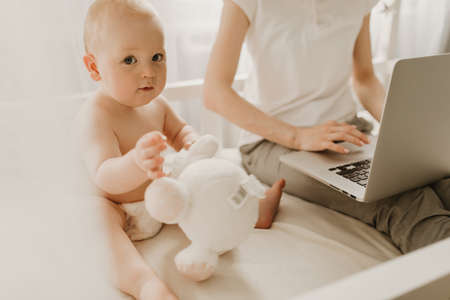1. Understanding the Basics of Baby Wipes
Baby wipes are a staple in most American households with infants and toddlers. They’re not just for diaper changes—many parents use them for quick cleanups after meals, wiping sticky hands and faces, or even cleaning toys and surfaces when on the go. But what exactly are baby wipes, how are they made, and why do they matter so much in daily baby care?
What Are Baby Wipes?
Baby wipes are disposable sheets designed to clean delicate baby skin. Typically, they come in packs or tubs that keep them moist and ready for use. Their main purpose is to remove dirt, messes, and bacteria gently without irritating sensitive skin.
How Are Baby Wipes Made?
The process of making baby wipes involves a few key steps:
- Material Selection: Most wipes are made from nonwoven fabrics—think of these as soft, cloth-like materials that are durable yet gentle.
- Formulation: The fabric is soaked in a liquid solution containing water and a blend of ingredients such as cleansers, moisturizers, and preservatives.
- Packing: The moistened wipes are packaged in airtight containers to prevent drying out and maintain cleanliness until use.
Main Components of Baby Wipes
| Component | Purpose |
|---|---|
| Nonwoven Fabric | Provides structure; soft for baby’s skin |
| Water | Main ingredient; cleanses gently |
| Cleansers | Dissolves dirt and residue |
| Moisturizers | Prevents dryness; soothes skin |
| Preservatives | Keeps wipes fresh; prevents bacteria growth |
The Role of Baby Wipes in Everyday Routines
For American families, baby wipes play a crucial role in keeping both babies and surroundings clean throughout the day. They offer convenience during diaper changes—especially when you’re away from home—and help parents manage everyday messes quickly. Because babies’ skin can be sensitive to irritation or allergic reactions, choosing the right kind of wipe is an important part of caring for your little one’s health and comfort.
2. Key Ingredients in Baby Wipes: What to Look For
Choosing the right baby wipes can make a big difference for your babys comfort and skin health. Understanding what ingredients are in your wipes—and why they matter—can help you make the best choice for your family. Let’s break down some of the most essential, safe, and beneficial ingredients commonly found in high-quality baby wipes.
Purified Water: The Main Ingredient
Most top-rated baby wipes use purified water as their primary ingredient. Purified water is gentle on sensitive skin, helps clean effectively, and reduces the risk of irritation or allergic reactions. Since babies’ skin is much thinner than adults, it’s important that the main cleansing agent is as mild as possible.
Gentle Cleansers
Quality wipes include gentle cleansers, often derived from coconut or other plant sources. These cleansers help lift away dirt and mess without stripping natural oils from your babys skin. Here’s a quick look at common mild cleansers:
| Ingredient Name | Source | Why Its Used |
|---|---|---|
| Cocamidopropyl Betaine | Coconut oil | Mild surfactant that gently cleanses |
| Decyl Glucoside | Corn glucose & coconut oil | Plant-based cleanser, non-irritating |
| Sodium Citrate | Citrus fruits | Maintains pH balance, supports cleaning action |
Plant-Based Moisturizers and Skin Soothers
To keep your baby’s skin soft and comfortable, many wipes include plant-based moisturizers and soothing agents. These ingredients help prevent dryness and support skin health:
| Ingredient Name | Main Benefit | Common Source |
|---|---|---|
| Aloe Vera Extract | Soothes and hydrates irritated skin | Aloe vera plant leaves |
| Chamomile Extract | Reduces redness, calms sensitive skin | Chamomile flowers |
| Vitamin E (Tocopherol) | Nourishes and protects skin barrier | Plant oils (such as sunflower) |
| Glycerin (Vegetable Derived) | Makes wipes moist, prevents dryness | Soybean or coconut oil, palm oil |
No Harsh Chemicals or Artificial Fragrances Needed!
The best baby wipes avoid harsh chemicals and synthetic fragrances that can irritate delicate skin. Instead, they rely on natural, simple ingredients to do the job gently and effectively.
If you’re shopping for baby wipes in the U.S., look for products labeled as “hypoallergenic,” “fragrance-free,” or “dermatologist-tested” for extra peace of mind.
![]()
3. Ingredients to Avoid in Baby Wipes
When choosing baby wipes, it’s important to know which ingredients might not be the best for your baby’s delicate skin. Some common substances used in wipes can be irritating or even harmful, especially for newborns or babies with sensitive skin. Let’s take a closer look at what to avoid and why.
Potentially Harmful or Irritating Substances
| Ingredient | Why Avoid It? |
|---|---|
| Fragrances (Parfum) | Added scents can cause skin irritation, allergies, or rashes. Many fragrances are made from synthetic chemicals that are not always disclosed on labels. |
| Alcohol (Ethanol/Isopropyl Alcohol) | Alcohol can dry out and irritate a baby’s sensitive skin, leading to redness and discomfort. |
| Parabens (Methylparaben, Propylparaben) | These preservatives have been linked to hormone disruption and potential allergic reactions. Many parents prefer paraben-free options for safety. |
| Phenoxyethanol | This preservative may cause skin irritation in some babies and is restricted in baby products in certain countries. |
| Methylisothiazolinone (MIT) & Methylchloroisothiazolinone (CMIT) | These preservatives are known allergens and have been associated with severe skin reactions. They are banned from leave-on products in the US and EU. |
| Propylene Glycol | This chemical helps retain moisture but can cause irritation or allergic reactions on sensitive skin. |
| Sodium Lauryl Sulfate (SLS) | A harsh cleansing agent that may strip away natural oils and irritate the skin barrier. |
| Artificial Dyes (FD&C Colors) | Dyes add no benefit and may trigger allergies or sensitivities, especially in babies prone to eczema. |
Why These Ingredients Might Not Be Suitable for Babies
Babies’ skin is much thinner and more delicate than adult skin. This means it absorbs substances more easily and is more prone to irritation. Ingredients like strong preservatives, synthetic fragrances, alcohol, and harsh chemicals can disrupt the natural protective barrier of the skin, leading to dryness, redness, or even allergic reactions. For these reasons, pediatricians often recommend choosing fragrance-free, hypoallergenic baby wipes with a simple ingredient list whenever possible.
4. How to Read and Understand Labels
When it comes to choosing baby wipes, reading the label can feel overwhelming. With so many ingredients and marketing buzzwords, its easy to get confused. Here’s how you can become a savvy shopper and pick the right wipes for your baby.
Understanding Common Ingredients
Start by scanning the ingredient list. Ingredients are listed in order of quantity, from highest to lowest. The first few items make up most of the product. Here’s a quick guide to help you:
| Ingredient | What It Does | Should You Worry? |
|---|---|---|
| Water (Aqua) | Main base, provides moisture | No, usually safe |
| Glycerin | Keeps skin soft and prevents dryness | No, generally safe unless allergic |
| Phenoxyethanol | Preservative to prevent bacteria growth | Use caution, may irritate sensitive skin |
| Parabens | Preservative | Avoid if possible; linked to health concerns |
| Fragrance/Parfum | Adds scent | Avoid for sensitive skin; can cause irritation |
| Aloe Vera/Chamomile Extracts | Soothes skin | No, usually gentle on skin |
| Alcohol (Ethanol/Isopropyl) | Kills germs, dries quickly | Avoid; can dry or irritate baby’s skin |
Spotting Misleading Marketing Terms
Brands often use catchy phrases that sound healthy but don’t always mean what you think. Here’s what to watch out for:
- “Hypoallergenic”: This means less likely to cause allergies, but there is no legal standard in the US for this term.
- “Natural”: Doesn’t guarantee safety—natural ingredients can still be irritating or allergenic.
- “Dermatologist-Tested”: Indicates some level of testing but does not guarantee suitability for all babies.
- “Eco-Friendly/Biodegradable”: Good for the planet, but still check the ingredient list for your baby’s safety.
- “Unscented” vs “Fragrance-Free”: “Unscented” products might contain masking scents; “fragrance-free” is usually safer for sensitive skin.
Tips for Choosing the Right Wipes for Your Family Values and Needs
- Sensitive Skin? Look for fragrance-free and alcohol-free options with minimal ingredients.
- Chemical Conscious? Avoid parabens, phthalates, and artificial dyes or perfumes.
- Caring About Sustainability? Choose wipes labeled biodegradable or made from plant-based fibers.
- Budget-Minded? Generic brands can be just as safe—always check labels rather than going by brand name alone.
- Cruelty-Free? Look for certification logos like Leaping Bunny or PETA on packaging.
Your Checklist When Reading Labels
- Scan the first five ingredients—they make up most of the wipe.
- Avoid long lists of hard-to-pronounce chemicals.
- If unsure about an ingredient, look it up on trusted resources like EWG’s Skin Deep Database.
- Select products that meet your family’s unique values—whether that means fewer chemicals, cruelty-free testing, or eco-friendly packaging.
By learning how to read and understand labels, you’ll feel more confident about what you’re using on your baby’s delicate skin—and find a product that fits your family just right.
5. Expert Tips for Choosing the Best Baby Wipes
What Pediatricians and Dermatologists Recommend
When it comes to picking the right baby wipes, pediatricians and dermatologists agree that every babys skin is unique. Some babies have ultra-sensitive skin, while others may be prone to eczema or dryness. Here’s what the experts suggest:
- For Sensitive Skin: Look for fragrance-free and alcohol-free wipes. Ingredients like aloe vera and vitamin E can be soothing, but always test a small area first.
- For Normal Skin: Most water-based wipes are gentle enough. Still, avoid harsh chemicals like parabens, phthalates, and sulfates.
- For Eczema-Prone Skin: Opt for hypoallergenic wipes with minimal ingredients and no added preservatives or dyes.
Common Ingredients: What to Look For and Avoid
| Ingredients to Look For | Ingredients to Avoid |
|---|---|
| Purified Water | Alcohol (Ethanol) |
| Aloe Vera | Fragrances/Perfumes |
| Glycerin | Parabens |
| Cotton or Plant-Based Fibers | Phthalates |
| Vitamin E (Tocopherol) | Sulfates (SLS/SLES) |
| Dyes/Artificial Colors |
Eco-Friendly & Budget-Conscious Alternatives
If you’re looking to reduce your environmental footprint or save money, there are great options beyond traditional disposable wipes:
- Reusable Cloth Wipes: Made from organic cotton or bamboo, these can be washed and reused many times.
- Biodegradable Wipes: Choose wipes made with plant-based fibers that break down more easily in landfills.
- DIY Baby Wipes: Make your own at home using soft cloths, purified water, and a touch of coconut oil or baby-safe soap.
Quick Comparison of Eco-Friendly Options
| Type | Main Benefit | Main Consideration |
|---|---|---|
| Reusable Cloth Wipes | Saves money long-term; zero waste | Requires frequent washing and drying |
| Biodegradable Wipes | Easier on the environment than traditional wipes | Might be slightly more expensive per pack |
| DIY Baby Wipes | You control all ingredients; very budget-friendly | Takes time to prepare; needs proper storage to stay fresh |
Pediatrician-Approved Shopping Checklist:
- No harsh chemicals or synthetic fragrances listed in the ingredients panel.
- Cruelty-free and dermatologist-tested labels add extra peace of mind.
- If using reusable options, choose materials labeled “organic” or “OEKO-TEX certified.”


